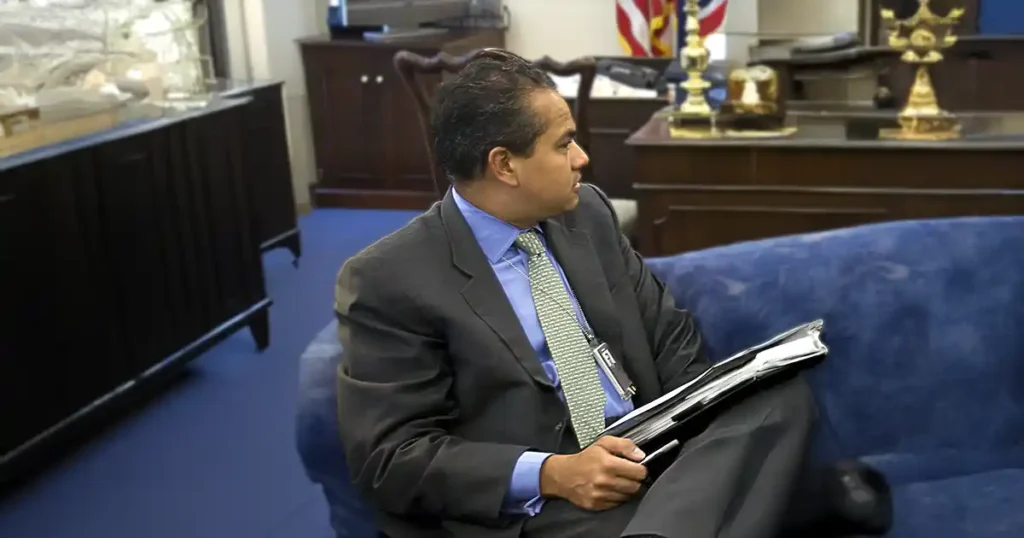The H-1B visa program, designed to bring skilled foreign workers into the United States, has been a cornerstone of America’s immigration and employment policy for decades. It has become particularly integral to the tech industry, which relies heavily on a global talent pool to maintain its competitive edge. However, the program has also been a subject of controversy, with debates ranging from economic impacts to ethical considerations. Neil Patel, former adviser to Vice President Dick Cheney and a co-founder of The Daily Caller, has offered his perspective on why big tech firms are so enamored with H-1Bs. His analysis sheds light on the multifaceted reasons behind the tech industry’s reliance on this program, sparking critical discussions on its broader implications.

The H-1B Program: A Brief Overview
The H-1B visa allows U.S. employers to temporarily hire foreign workers in specialty occupations that require theoretical or technical expertise. These positions are often in fields like IT, engineering, finance, and medicine. The program has an annual cap, with 85,000 visas available each year, including 20,000 reserved for applicants with advanced degrees from U.S. institutions.
While the H-1B program was initially designed to fill skill gaps in the U.S. labor market, it has evolved into a key instrument for tech giants such as Google, Microsoft, and Amazon to tap into a global talent pool. According to Patel, the program’s appeal to big tech is driven by several intertwined factors that extend beyond simple workforce augmentation.
Cost Efficiency: The Economic Argument
One of the most compelling reasons big tech companies favor H-1Bs is cost efficiency. Patel argues that while H-1B workers are often highly skilled, they typically earn less than their U.S. counterparts for similar roles. This wage differential exists due to various factors, including the dependency of H-1B workers on their sponsoring employers for legal residency. This dependency creates an imbalance in negotiating power, allowing companies to offer lower salaries.
Critics of the program argue that this practice undercuts the domestic labor market, potentially suppressing wages for U.S. workers. However, tech companies counter that the H-1B program enables them to remain globally competitive by reducing operational costs and reinvesting savings into innovation and growth.
The Talent Gap: A Justification for Demand
Big tech’s reliance on H-1Bs is often justified by the talent gap in the U.S. labor market. According to Patel, the demand for highly skilled professionals, particularly in STEM fields, far outpaces the domestic supply. U.S. universities produce a limited number of graduates in these fields, and the education system struggles to keep pace with the rapid technological advancements driving the industry.
H-1B workers help fill this gap, bringing expertise in areas like artificial intelligence, cloud computing, and cybersecurity. Patel points out that this reliance on foreign talent underscores the need for systemic reforms in U.S. education to better prepare the domestic workforce for the jobs of the future.
Innovation and Diversity: The Competitive Edge
Patel highlights another crucial aspect of the H-1B program: its role in fostering innovation and diversity. Big tech firms operate in a globalized world, where diverse perspectives and experiences are essential for developing products and services that resonate with a wide audience. By hiring talent from around the globe, these companies gain access to unique problem-solving approaches and cultural insights that drive creativity and innovation.
Moreover, H-1B workers often come from countries with strong educational systems in technical fields, such as India and China. These workers bring not only their technical skills but also a global mindset that enhances the collaborative environment within tech firms.
The Controversies Surrounding H-1Bs
Despite its benefits, the H-1B program is not without controversy. Patel addresses several criticisms that have fueled debates about the program’s implementation and impact.
Job Displacement
One of the primary concerns is that H-1B workers displace U.S. employees. Critics argue that companies exploit the program to replace domestic workers with cheaper foreign labor, citing high-profile cases where U.S. workers were allegedly forced to train their H-1B replacements.
Dependency and Exploitation
The dependency of H-1B workers on their sponsoring employers for legal status creates a power dynamic that can lead to exploitation. Workers may feel compelled to accept unfavorable working conditions or hesitate to report grievances, fearing visa revocation or job loss.
Lack of Oversight
Patel points out that the program’s lack of stringent oversight has enabled some companies to abuse it. For instance, “body shop” firms that act as intermediaries between H-1B workers and tech companies have been accused of misusing the program to maximize profits at the expense of workers’ rights and the program’s original intent.
Policy Implications and Reform Proposals
Given the controversies surrounding the H-1B program, Patel suggests several policy reforms to address its shortcomings while preserving its benefits for the tech industry and the broader economy.
Raising Wage Requirements
One proposed reform is to increase the minimum wage requirements for H-1B workers. This measure could help level the playing field between foreign and domestic workers, reducing wage suppression and incentivizing companies to hire based on merit rather than cost.
Prioritizing High-Skilled Workers
Another suggestion is to prioritize H-1B applications based on skill level and salary offers. Such a system would ensure that the program benefits the most qualified and highly compensated workers, aligning with its original intent of addressing skill shortages.
Strengthening Oversight
Enhanced oversight and stricter enforcement of program rules could mitigate abuses. Patel advocates for measures such as random audits of H-1B employers and penalties for violations to ensure compliance and accountability.
Investing in Domestic Talent
Finally, Patel emphasizes the importance of long-term investments in U.S. education and workforce development. By expanding access to STEM education and training programs, the U.S. can reduce its reliance on foreign talent while fostering a more robust and self-sufficient labor market.
The Broader Implications
The H-1B program exemplifies the complex interplay between immigration policy, economic growth, and global competitiveness. Patel’s insights reveal how big tech’s reliance on H-1Bs reflects broader challenges in the U.S. labor market and education system. While the program has undoubtedly contributed to the success of the tech industry, its controversies highlight the need for thoughtful reforms that balance the interests of all stakeholders.
In the end, the debate over H-1Bs is about more than just visas or tech jobs. It’s a conversation about how America positions itself in a rapidly evolving global economy and how it ensures that opportunity and innovation remain accessible to all.
The Backbone of Innovation: The Role of H-1B Visas in Big Tech
The U.S. tech sector thrives on innovation, and much of that innovation is driven by a workforce that is both diverse and highly skilled. H-1B visas have been instrumental in ensuring that companies can access the global talent pool necessary to maintain their competitive edge.
Access to Global Talent
One of the primary reasons big tech companies advocate for the H-1B program is the access it provides to an international talent pool. According to a report by the National Foundation for American Policy (NFAP), over 70% of tech-related H-1B visa holders possess advanced degrees. This high level of education is often critical for roles in cutting-edge fields like artificial intelligence (AI), machine learning, and quantum computing.
“The demand for highly specialized skills often outpaces the supply available in the U.S. workforce,” says Patel. “Without access to foreign talent, America risks losing its edge in global innovation.”
Filling the Skills Gap
Despite the growing emphasis on STEM (Science, Technology, Engineering, and Mathematics) education in the U.S., a significant skills gap persists. Data from the Bureau of Labor Statistics (BLS) indicates that there are more job openings in tech than there are qualified candidates to fill them. H-1B visas help bridge this gap, allowing companies to hire foreign workers with the expertise needed to address these shortages.
Driving Economic Growth
Beyond individual companies, the H-1B program contributes to broader economic growth. Studies have shown that H-1B workers not only fill critical roles but also create additional jobs by driving innovation and increasing productivity. For instance, a 2018 study published in the journal American Economic Review found that H-1B-driven innovation led to the creation of jobs for native-born workers as well.
The Controversies: Challenges and Criticisms of the H-1B Program
While the benefits of the H-1B visa program are evident, it’s not without its controversies. Critics argue that the program has been exploited by some companies, leading to adverse effects on both foreign and domestic workers.
Wage Suppression
One of the most common criticisms is that the H-1B program enables wage suppression. Critics claim that some employers use H-1B visas to hire foreign workers at lower wages than their American counterparts, thus driving down industry standards.
“The program was designed to fill gaps, not to undercut wages,” Patel explains. “Reforming wage requirements could help address these concerns.”
Outsourcing Concerns
Another contentious issue is the use of H-1B visas by outsourcing firms. Companies that specialize in outsourcing often account for a significant portion of H-1B visa applications, raising concerns that the program is being used to transfer jobs overseas rather than address domestic shortages.
Exploitation of Foreign Workers
H-1B workers are tied to their sponsoring employers, which can lead to exploitation. Stories of workers being underpaid, overworked, or even threatened with deportation have fueled calls for reform. Patel highlights the need for stronger worker protections to prevent such abuses.
Neil Patel’s Perspective: A Balanced Approach
Neil Patel’s experience in policy-making gives him a unique vantage point on the H-1B debate. He advocates for a balanced approach that maximizes the program’s benefits while addressing its shortcomings.
The Need for Reform
Patel acknowledges that the H-1B program has its flaws but believes they can be addressed through targeted reforms. Key recommendations include:
- Raising Wage Standards: Ensuring that H-1B workers are paid competitive wages can help prevent wage suppression and exploitation.
- Prioritizing High-Skilled Workers: Allocating visas based on skill levels and industry needs can ensure that the program serves its intended purpose.
- Strengthening Oversight: Increased transparency and accountability can prevent misuse of the program by outsourcing firms and unscrupulous employers.
Balancing Domestic and Foreign Talent
Patel emphasizes the importance of balancing the need for foreign talent with investments in the domestic workforce. “We need to focus on STEM education and vocational training to prepare more Americans for high-tech jobs,” he says. “At the same time, we can’t afford to close the door on global talent.”
A Global Perspective
In a globalized economy, Patel argues, the U.S. must view immigration policy through an international lens. Restrictive policies could push top talent to other countries, such as Canada or Australia, where immigration pathways for skilled workers are more accessible.
The Road Ahead: Balancing Opportunity and Accountability
The H-1B visa program remains a critical component of America’s economic and innovation strategy. However, its success depends on the ability to balance opportunity with accountability. By addressing wage issues, preventing exploitation, and investing in domestic education, the program can continue to benefit both American workers and global talent.
As Patel concludes, “The goal isn’t to pit domestic workers against foreign workers. It’s to build an economy where both can thrive.”






